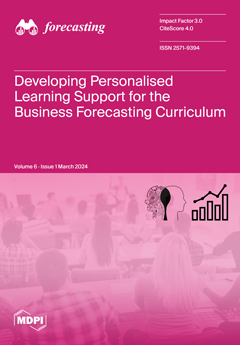In today’s evolving global world, the pharmaceutical sector faces an emerging challenge, which is the rapid surge of the global population and the consequent growth in drug production demands. Recognizing this, our study explores the urgent need to strengthen pharmaceutical production capacities, ensuring
[...] Read more.
In today’s evolving global world, the pharmaceutical sector faces an emerging challenge, which is the rapid surge of the global population and the consequent growth in drug production demands. Recognizing this, our study explores the urgent need to strengthen pharmaceutical production capacities, ensuring drugs are allocated and stored strategically to meet diverse regional and demographic needs. Summarizing our key findings, our research focuses on the promising area of drug demand forecasting using artificial intelligence (AI) and machine learning (ML) techniques to enhance predictions in the pharmaceutical field. Supplied with a rich dataset from Kaggle spanning 600,000 sales records from a singular pharmacy, our study embarks on a thorough exploration of univariate time series analysis. Here, we pair conventional analytical tools such as ARIMA with advanced methodologies like LSTM neural networks, all with a singular vision: refining the precision of our sales. Venturing deeper, our data underwent categorisation and were segmented into eight clusters premised on the ATC Anatomical Therapeutic Chemical (ATC) Classification System framework. This segmentation unravels the evident influence of seasonality on drug sales. The analysis not only highlights the effectiveness of machine learning models but also illuminates the remarkable success of XGBoost. This algorithm outperformed traditional models, achieving the lowest MAPE values: 17.89% for M01AB (anti-inflammatory and antirheumatic products, non-steroids, acetic acid derivatives, and related substances), 16.92% for M01AE (anti-inflammatory and antirheumatic products, non-steroids, and propionic acid derivatives), 17.98% for N02BA (analgesics, antipyretics, and anilides), and 16.05% for N02BE (analgesics, antipyretics, pyrazolones, and anilides). XGBoost further demonstrated exceptional precision with the lowest MSE scores: 28.8 for M01AB, 1518.56 for N02BE, and 350.84 for N05C (hypnotics and sedatives). Additionally, the Seasonal Naïve model recorded an MSE of 49.19 for M01AE, while the Single Exponential Smoothing model showed an MSE of 7.19 for N05B. These findings underscore the strengths derived from employing a diverse range of approaches within the forecasting series. In summary, our research accentuates the significance of leveraging machine learning techniques to derive valuable insights for pharmaceutical companies. By applying the power of these methods, companies can optimize their production, storage, distribution, and marketing practices.
Full article





